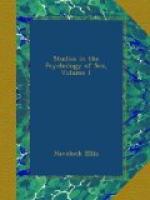It was not possible any longer to maintain the womb theory of Hippocrates in its crude form, but in modified forms, and especially with the object of preserving the connection which many observers continued to find between hysteria and the sexual emotions, it still found supporters in the eighteenth and even the nineteenth centuries. James, in the middle of the eighteenth century, returned to the classical view, and in his Dictionary of Medicine maintained that the womb is the seat of hysteria. Louyer Villermay in 1816 asserted that the most frequent causes of hysteria are deprivation of the pleasures of love, griefs connected with this passion, and disorders of menstruation. Foville in 1833 and Landouzy in 1846 advocated somewhat similar views. The acute Laycock in 1840 quoted as “almost a medical proverb” the saying, “Salacitas major, major ad hysteriam proclivitas,” fully indorsing it. More recently still Clouston has defined hysteria as “the loss of the inhibitory influence exercised on the reproductive and sexual instincts of women by the higher mental and moral functions” (a position evidently requiring some modification in view of the fact that hysteria is by no means confined to women), while the same authority remarks that more or less concealed sexual phenomena are the chief symptoms of “hysterical insanity."[259] Two gynaecologists of high position in different parts of the world, Hegar in Germany and Balls-Headley in Australia, attribute hysteria, as well as anaemia, largely to unsatisfied sexual desire, including the non-satisfaction of the “ideal feelings."[260] Lombroso and Ferrero, again, while admitting that the sexual feelings might be either heightened or depressed in hysteria, referred to the frequency of what they termed “a paradoxical sexual instinct” in the hysterical, by which, for instance, sexual frigidity is combined with intense sexual pre-occupations; and they also pointed out the significant fact that the crimes of the hysterical nearly always revolve around the sexual sphere.[261] Thus, even up to the time when the conception of hysteria which absolutely ignored and excluded any sexual relationship whatever had reached its height, independent views favoring such a relationship still found expression.
Of recent years, however, such views usually aroused violent antagonism. The main current of opinion was with Briquet (1859), who, treating the matter with considerable ability and a wide induction of facts, indignantly repelled the idea that there is any connection between hysteria and the sexual facts of life, physical or psychic. As he himself admitted, Briquet was moved to deny a sexual causation of hysteria by the thought that such an origin would be degrading for women ("a quelque chose de degradant pour les femmes").




